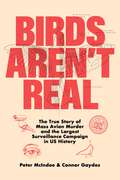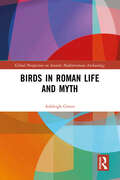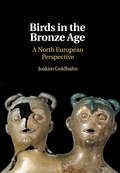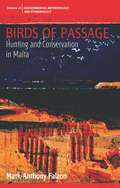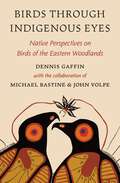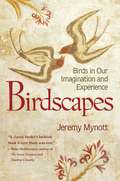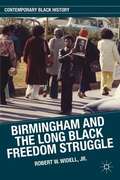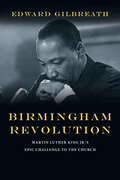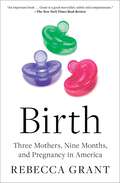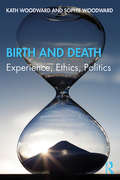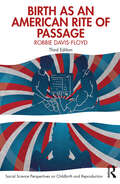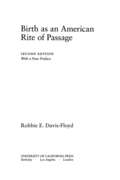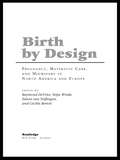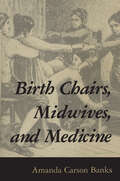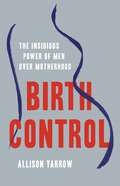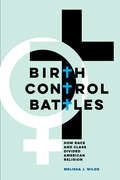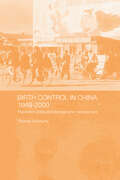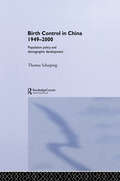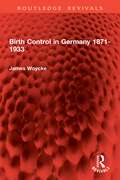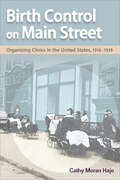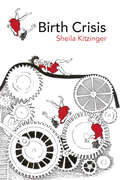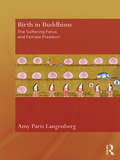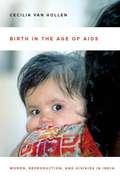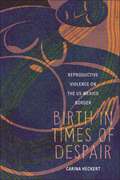- Table View
- List View
Birds Aren't Real: The True Story of Mass Avian Murder and the Largest Surveillance Campaign in US History
by Peter McIndoe Connor GaydosThe true story of the greatest conspiracy in US history—and how to fight back.Have you ever seen a baby pigeon? You haven’t, have you? No one has, not in many, many years. They used to be everywhere. You couldn’t walk out of your front door in New York City in the 1930s without seeing dozens of those little guys scurrying around. Today, there are millions of grown up pigeons in New York, but not a baby pigeon to be seen. That’s because they come out of the factory as adults.This is one of the many smoking guns of the bird drone surveillance crisis. Since 1959, the Deep State has mercilessly slaughtered over 12 billion birds and replaced them with identical drones that are designed to spy on private citizens and report their every action directly to the government. From pet canaries to Sesame Street, the shadowy figures that pull the strings have infiltrated every aspect of our society, making a mockery of civil liberties while the American people live in blissful ignorance. Until now.In Birds Aren’t Real, whistleblowers Peter McIndoe and Connor Gaydos trace the roots of a political conspiracy so vast and well-hidden that it almost seems like an elaborate hoax. These hero Bird Truthers have risked life and limb to compile and disseminate a treasure trove of information about the origins of the surveillance crisis, its spread, and the patriots who are on the front lines today, raising awareness and working to reclaim America as the land of the free. This urgent manifesto features a host of useful illustrations, activities, and leaked classified documents that will convince even the most outspoken skeptic that birds aren’t real. The truth is out there: will you stand and fight before it’s too late?
Birds in Roman Life and Myth (Global Perspectives on Ancient Mediterranean Archaeology)
by Ashleigh GreenThis book explores the place of birds in Roman myth and everyday life, focusing primarily on the transitional period of 100 BCE to 100 CE within the Italian peninsula. A diverse range of topics is considered in order to build a broad overview of the subject. Beginning with an appraisal of omens, augury, and auspices – including the ‘sacred chickens’ consulted by generals before battle – it goes on to examine how Romans farmed birds, hunted them, and kept them as pets. It demonstrates how the ownership and consumption of birds were used to communicate status and prestige, and how bird consumption mirrored wider economic and social trends. Each topic adopts an interdisciplinary approach, considering literary evidence alongside art, material culture, zooarchaeology, and modern ornithological knowledge. The inclusion of zooarchaeology adds another dimension to the work and highlights the value of using animals and faunal remains to interpret the past. Studying the Roman view of birds offers great insight into how they conceived of their relationship with the gods and how they stratified and organised their society. This book is a valuable resource for bird lovers and researchers alike, particularly those studying animals in the ancient world.
Birds in the Bronze Age: A North European Perspective
by Joakim GoldhahnThis book provides new insights into the relationship between humans and birds in Northern Europe during the Bronze Age. Joakim Goldhahn argues that birds had a central role in Bronze Age society and imagination, as reflected in legends, myths, rituals, and cosmologies. Goldhahn offers a new theoretical model for understanding the intricate relationship between humans and birds during this period. He explores traces of birds found in a range of archaeological context, including settlements and burials, and analyzes depictions of birds on bronze artefacts and figurines, rock art, and ritual paraphernalia. He demonstrates how birds were used in divinations, and provides the oldest evidence of omens taken from gastric contents of birds - extispicy - ever found in Europe.
Birds of Passage: Hunting and Conservation in Malta (Environmental Anthropology and Ethnobiology #25)
by Mark-Anthony FalzonBird migration between Europe and Africa is a fraught journey, particularly in the Mediterranean, where migratory birds are shot and trapped in large numbers. In Malta, thousands of hunters share a shrinking countryside. They also rub shoulders with a strong bird-protection and conservation lobby. Drawing on years of ethnographic fieldwork, this book traces the complex interactions between hunters, birds and the landscapes they inhabit, as well as the dynamics and politics of bird conservation. Birds of Passage looks at the practice and meaning of hunting in a specific context, and raises broader questions about human-wildlife interactions and the uncertain outcomes of conservation.
Birds of Passage: Hunting and Conservation in Malta (Environmental Anthropology and Ethnobiology #25)
by Mark-Anthony FalzonBird migration between Europe and Africa is a fraught journey, particularly in the Mediterranean, where migratory birds are shot and trapped in large numbers. In Malta, thousands of hunters share a shrinking countryside. They also rub shoulders with a strong bird-protection and conservation lobby. Drawing on years of ethnographic fieldwork, this book traces the complex interactions between hunters, birds and the landscapes they inhabit, as well as the dynamics and politics of bird conservation. Birds of Passage looks at the practice and meaning of hunting in a specific context, and raises broader questions about human-wildlife interactions and the uncertain outcomes of conservation.
Birds through Indigenous Eyes: Native Perspectives on Birds of the Eastern Woodlands
by Dennis GaffinAn intimate and personal account of the profound roles birds play in the lives of some Indigenous peopleFor many hours over a period of years, white anthropologist Dennis Gaffin and two Indigenous friends, Michael Bastine and John Volpe, recorded their conversations about a shared passion: the birds of upstate New York and southern Ontario. In these lively, informal talks, Bastine (a healer and naturalist of Algonquin descent) and Volpe (a naturalist and animal rehabilitator of Ojibwe and Métis descent) shared their experiences of, and beliefs about, birds, describing the profound spiritual, psychological, and social roles of birds in the lives of some Indigenous people. Birds through Indigenous Eyes presents highlights of these conversations, placing them in context and showing how Native understandings of birds contrast with conventional Western views.Bastine and Volpe bring to life Algonquin, Ojibwe, and Haudenosaunee (Iroquois) beliefs about birds. They reveal how specific birds and bird species are seamlessly integrated into spirituality and everyday thought and action, how birds bring important messages to individual people, how a bird species can become associated with a person, and how birds provide warnings about our endangered environment. Over the course of the book, birds such as the house sparrow, Eastern phoebe, Northern flicker, belted kingfisher, gray catbird, cedar waxwing, and black-capped chickadee are shown in a new light—as spiritual and practical helpers that can teach humans how to live well.An original work of ethno-ornithology that offers a rare close-up look at some Native views on birds, Birds through Indigenous Eyes opens rich new perspectives on the deep connections between birds and humans.
Birdscapes: Birds in Our Imagination and Experience (Princeton Shorts Ser.)
by Jeremy MynottWhat draws us to the beauty of a peacock, the flight of an eagle, or the song of a nightingale? Why are birds so significant in our lives and our sense of the world? And what do our ways of thinking about and experiencing birds tell us about ourselves? Birdscapes is a unique meditation on the variety of human responses to birds, from antiquity to today, and from casual observers to the globe-trotting "twitchers" who sometimes risk life, limb, and marriages simply to add new species to their "life lists." Drawing extensively on literature, history, philosophy, and science, Jeremy Mynott puts his own experiences as a birdwatcher in a rich cultural context. His sources range from the familiar--Thoreau, Keats, Darwin, and Audubon--to the unexpected--Benjamin Franklin, Giacomo Puccini, Oscar Wilde, and Monty Python. Just as unusual are the extensive illustrations, which explore our perceptions and representations of birds through images such as national emblems, women's hats, professional sports logos, and a Christmas biscuit tin, as well as classics of bird art. Each chapter takes up a new theme--from rarity, beauty, and sound to conservation, naming, and symbolism--and is set in a new place, as Mynott travels from his "home patch" in Suffolk, England, to his "away patch" in New York City's Central Park, as well as to Russia, Australia, and Greece. Conversational, playful, and witty, Birdscapes gently leads us to reflect on large questions about our relation to birds and the natural world. It encourages birders to see their pursuits in a broader human context--and it shows nonbirders what they may be missing.
Birmingham And The Long Black Freedom Struggle
by Robert W. Widell Jr.Birmingham, Alabama looms large in the history of the twentieth-century black freedom struggle, but to date historians have mostly neglected the years after 1963. Here, author Robert Widell explores the evolution of Birmingham black activism into the 1970s, providing a valuable local perspective on the "long" black freedom struggle.
Birmingham Revolution: Martin Luther King Jr.'s Epic Challenge to the Church
by Edward GilbreathBirmingham Revolution
Birth: Three Mothers, Nine Months, and Pregnancy in America
by Rebecca Grant&“An important book...Grant is a good storyteller, subtle and compassionate.&” —The New York Times Book Review In the tradition of Random Family and Evicted, a gripping blend of rigorous, intimate on-the-ground reporting and deep social history of reproductive health that follows three first-time mothers as they experience pregnancy and childbirth in today&’s America.Journalist Rebecca Grant provides us with a never-before-seen look at the changing landscape of pregnancy and childbirth in America—and the rise of midwifery—told through the eyes of three women who all pass through the doors of the same birth center in Portland, Oregon. There&’s Alison, a teacher whose long path to a healthy pregnancy has led her to question a traditional hospital birth; T&’Nika, herself born with the help of a midwife and now a nurse hoping to work in Labor & Delivery and improve equality in healthcare; and Jillian, an office manager and aspiring midwife who works at Andaluz Birth Center, excited for a new beginning, but anxious about how bringing a new life into the world might mean the deferral of her own dreams. In remarkable detail and with great compassion, Grant recounts the ups downs, fears, joys, and everyday moments of each woman&’s pregnancy and postpartum journey, offering a rare look into their inner lives, perspectives, and choices in real time—and addresses larger issues facing the entire nation, from discrimination in medicine and treatment (both gender and race-based) to fertility, family planning, complicated feelings about motherhood and career, and the stigmas of miscarriage and postpartum blues. &“An enlightening and accessible portrait of maternal healthcare in America" (Publishers Weekly, starred) Birth is an inspiring look at one of life&’s most profound rites of passage.
Birth and Death: Experience, Ethics, Politics
by Kath Woodward Sophie WoodwardUsually conceived in opposition to each other – birth as a hopeful beginning, death as an ending – this book brings them into dialogue with each other to argue that both are central to our experiences of being in the world and part of living. Written by two authors, this book takes an intergenerational approach to highlight the connections and disconnections between birth and death; adopting a relational approach allows the book to explore birth and death through the key relationships that constitute them: personal and social, private and public, the affective and social norms, the actual and the virtual and the ordinary and profound. Of interest to academics and students in the fields of feminism, phenomenology and the life course, the book will also be of relevance to policy makers in the areas of birth activism and end of life care. Drawing from personal stories, everyday life and publicly contested examples, the book will also be of interest to a more general readership as it engages with questions we all at some point will grapple with.
Birth as an American Rite of Passage (Social Science Perspectives on Childbirth and Reproduction)
by Robbie Davis-FloydThis classic book, first published in 1992 and again in 2003, has inspired three generations of childbearing people, birth activists and researchers, and birth practitioners—midwives, doulas, nurses, and obstetricians—to take a fresh look at the "standard procedures" that are routinely used to "manage" American childbirth. It was the first book to identify these non-evidence-based obstetric interventions as rituals that enact and transmit the core values of the American technocracy, thereby answering the pressing question of why these interventions continue to be performed despite all evidence to the contrary. This third edition brings together Davis-Floyd's insights into the intense ritualization of labor and birth and the technocratic, humanistic, and holistic models of birth with new data collected in recent years.
Birth as an American Rite of Passage
by Robbie E. Davis-FloydWhy do so many American women allow themselves to become enmeshed in the standardized routines of technocratic childbirth--routines that can be insensitive, unnecessary, and even unhealthy? Anthropologist Robbie Davis-Floyd first addressed these questions in the 1992 edition. Her new preface to this 2003 edition of a book that has been read, applauded, and loved by women all over the world, makes it clear that the issues surrounding childbirth remain as controversial as ever.
Birth By Design: Pregnancy, Maternity Care and Midwifery in North America and Europe
by Raymond DeVries Sirpa Wrede Edwin Van Teijlingen Cecilia BenoitFirst published in 2001. Routledge is an imprint of Taylor & Francis, an informa company.
Birth Chairs, Midwives, and Medicine
by Amanda Carson BanksThere was a time when birth was treated as a natural process rather than a medical condition. Before 1800, women gave birth seated in birth chairs or on stools and were helped along by midwives. Then societal changes in attitudes toward women and the practice of medicine made birthing a province of the male-dominated medical profession. In Birth Chairs, Midwives, and Medicine, Amanda Carson Banks examines the history of the birth chair and tells how this birthing device changed over time. Through photographs, artists' renditions of births, interviews, and texts from midwives and early obstetricians, she creates an evolutionary picture of birthing practices and highlights the radical redefinition of birth that has occurred in the last two centuries. During the 1800s the change from a natural philosophy of birth to a medical one was partly a result of heightened understandings of anatomy and physiology. The medical profession was growing, and with it grew the awareness of the economic rewards of making delivery a specialized practice. In the background of the medical profession's rise was the prevailing perception of women as fragile invalids. Gradually, midwives and birth chairs were relegated to rural and isolated settings. The popularity of birth chairs has seen a revival in the late twentieth century as the struggle between medical obstetrics and the alternative birth movement has grown. As Banks shows through her careful examination of the chairs themselves, these questions have been answered and reconsidered many times in human history. Using the artifacts from the home and medical office, Banks traces sweeping societal changes in the philosophy of how to bring life into the world.
Birth Control: The Insidious Power of Men Over Motherhood
by Allison Yarrow"Supported by ample data and suffused with anger,&” an award-winning journalist &“convincingly recasts this country&’s maternal health care system as needlessly dehumanizing&” (New York Times Book Review). Modern medicine should make pregnancy and childbirth safer for all. But in Birth Control, award-winning journalist Allison Yarrow reveals how women are controlled, traumatized, injured, and even killed because of the traditionalist practices of medical professionals and hospitals. Ever since doctors stole control of birth from midwives in the 19th century, women have been steamrolled by a male-dominated medical establishment that has everyone convinced that birthing bodies are inherently flawed and that every pregnancy is a crisis that it alone can &“solve.&” Common medical practices and procedures violate human rights and the law, yet take place daily. Misogyny and racism, not scientific evidence and support, shape the overwhelming majority of America&’s four million annual births. Drawing on extensive reporting, expert interviews, an original survey of 1,300 mothers, and her own personal experiences, Yarrow documents how modern maternal health care is insidiously, purposefully designed to take power from women to the detriment of their physical and mental health—not just during labor, but for years after. She then shows a better way, exploring solutions both cutting-edge and ancient to—finally—return power and control to birthing people. Full of urgent insights and heartfelt emotion, Birth Control is an explosive call to action.
Birth Control Battles: How Race and Class Divided American Religion
by Melissa J. WildeConservative and progressive religious groups fiercely disagree about issues of sex and gender. But how did we get here? Melissa J. Wilde shows how today’s modern divisions began in the 1930s in the public battles over birth control and not for the reasons we might expect. By examining thirty of America’s most prominent religious groups—from Mormons to Methodists, Southern Baptists to Seventh Day Adventists, and many others—Wilde contends that fights over birth control had little do with sex, women’s rights, or privacy.Using a veritable treasure trove of data, including census and archival materials and more than 10,000 articles, statements, and sermons from religious and secular periodicals, Wilde demonstrates that the push to liberalize positions on contraception was tied to complex views of race, immigration, and manifest destiny among America’s most prominent religious groups. Taking us from the Depression era, when support for the eugenics movement saw birth control as an act of duty for less desirable groups, to the 1960s, by which time most groups had forgotten the reasons behind their stances on contraception (but not the concerns driving them), Birth Control Battles explains how reproductive politics divided American religion. In doing so, this book shows the enduring importance of race and class for American religion as it rewrites our understanding of what it has meant to be progressive or conservative in America.
Birth Control in China 1949-2000: Population Policy and Demographic Development (Chinese Worlds)
by Thomas ScharpingThis comprehensive volume analyzes Chinese birth policies and population developments from the founding of the People's Republic to the 2000 census. The main emphasis is on China's 'Hardship Number One Under Heaven': the highly controversial one-child campaign, and the violent clash between family strategies and government policies it entails.Birth Control in China 1949-2000 documents an agonizing search for a way out of predicament and a protracted inner Party struggle, a massive effort for social engineering and grinding problems of implementation. It reveals how birth control in China is shaped by political, economic and social interests, bureaucratic structures and financial concerns. Based on own interviews and a wealth of new statistics, surveys and documents, Thomas Scharping also analyzes how the demographics of China have changed due to birth control policies, and what the future is likely to hold. This book will be of interest to students and scholars of modern China, Asian studies and the social sciences.
Birth Control in China 1949-2000: Population Policy and Demographic Development (Chinese Worlds)
by Thomas ScharpingThis comprehensive volume analyses Chinese birth policies and population developments from the founding of the People's Republic to the 2000 census. The main emphasis is on China's 'Hardship Number One Under Heaven': the highly controversial one-child campaign, and the violent clash between family strategies and government policies it entails.Birth Control in China 1949-2000 documents an agonizing search for a way out of predicament and a protracted inner Party struggle, a massive effort for social engineering and grinding problems of implementation. It reveals how birth control in China is shaped by political, economic and social interests, bureaucratic structures and financial concerns. Based on own interviews and a wealth of new statistics, surveys and documents, Thomas Scharping also analyses how the demographics of China have changed due to birth control policies, and what the future is likely to hold. This book will be of interest to students and scholars of Modern China, Asian studies and the social sciences.
Birth Control in Germany 1871-1933 (Routledge Revivals)
by James WoyckeFirst published in 1988, Birth Control in Germany deals in detail with the dissemination and acceptance of ideas of birth control from 1871 -1933 and shows the variety of methods that were in use-condoms, pessaries, diaphragms, caps and most notably abortion. In common with many western societies, Germany experienced a notable decline in the birth rate as it entered into the 20th century. Demographers differ in their explanation for such changes in the birth rate. Some argue that fluctuating birth rates reflect society’s efforts to match population and economy, while others argue that modern low levels can only be the result of radical innovations in popular behavior. The author argues that the latter can be shown to be the case in the German instance. He further says that attitudes quite similar to those found in liberal circles today were widespread among ordinary men and women in Germany, in contrast to, for example, the pro natalist ideologies dominant in France in the same period. This despite the regional, class and religious differentials which influence the German picture.The book amounts to an important study of the sexual politics of pre–Nazi Germany, and study in modernization of a traditional society. This is an important historical work for scholars and researchers of German history, women's studies, health & reproductive history, European history, and gender studies.
Birth Control on Main Street: Organizing Clinics in the United States, 1916-1939
by Cathy Moran HajoUnearthing individual stories and statistical records from previously overlooked birth control clinics, Cathy Moran Hajo looks past the rhetoric of the birth control movement to show the relationships, politics, and issues that defined the movement in neighborhoods and cities across the United States. Whereas previous histories have emphasized national trends and glossed over the majority of clinics, Birth Control on Main Street contextualizes individual case studies to add powerful new layers to the existing narratives on abortion, racism, eugenics, and sterilization. Hajo draws on an original database of more than 600 clinics run by birth control leagues, hospitals, settlement houses, and public health groups to isolate the birth control clinic from the larger narrative of the moment. By revealing how clinics tested, treated, and educated women regarding contraceptives, she shows how clinic operation differed according to the needs and concerns of the districts it served. Moving thematically through the politicized issues of the birth control movement, Hajo infuses her analysis of the practical and medical issues of the clinics with unique stories of activists who negotiated with community groups to obey local laws and navigated the swirling debates about how birth control centers should be controlled, who should receive care, and how patients should be treated.
Birth Crisis
by Sheila KitzingerOne new mother in twenty is diagnosed with traumatic stress after childbirth. In Birth Crisis Sheila Kitzinger explores the disempowerment and anxiety experienced by these women. Key topics discussed include: increasing intervention in pregnancy the shift in emphasis from relationships to technology in childbirth how family, friends and professional caregivers can reach out to traumatized mothers how women can work through stress to understand themselves more deeply and grow in emotional maturity how care and the medical system needs to be changed. Birth Crisis draws on mothers' voices and real-life experiences to explore the suffering after childbirth which has, until now, been brushed under the carpet. It is a fascinating and useful resource for student and practising midwives, all health professionals, and women and their families who want to learn how to overcome a traumatic birth.
Birth in Buddhism: The Suffering Fetus and Female Freedom (Routledge Critical Studies in Buddhism)
by Amy Paris LangenbergRecent decades have seen a groundswell in the Buddhist world, a transnational agitation for better opportunities for Buddhist women. Many of the main players in the transnational nuns movement self-identify as feminists but other participants in this movement may not know or use the language of feminism. In fact, many ordained Buddhist women say they seek higher ordination so that they might be better Buddhist practitioners, not for the sake of gender equality. Eschewing the backward projection of secular liberal feminist categories, this book describes the basic features of the Buddhist discourse of the female body, held more or less in common across sectarian lines, and still pertinent to ordained Buddhist women today. The textual focus of the study is an early-first-millennium Sanskrit Buddhist work, "Descent into the Womb scripture" or Garbhāvakrānti-sūtra. Drawing out the implications of this text, the author offers innovative arguments about the significance of childbirth and fertility in Buddhism, namely that birth is a master metaphor in Indian Buddhism; that Buddhist gender constructions are centrally shaped by Buddhist birth discourse; and that, by undermining the religious importance of female fertility, the Buddhist construction of an inauspicious, chronically impure, and disgusting femininity constituted a portal to a new, liberated, feminine life for Buddhist monastic women. Thus, this study of the Buddhist discourse of birth is also a genealogy of gender in middle period Indian Buddhism. Offering a new critical perspective on the issues of gender, bodies and suffering, this book will be of interest to an interdisciplinary audience, including researchers in the field of Buddhism, South Asian history and religion, gender and religion, theory and method in the study of religion, and Buddhist medicine.
Birth in the Age of AIDS: Women, Reproduction, and HIV/AIDS in India
by Cecilia Van HollenBirth in the Age of AIDSis a vivid and poignant portrayal of the experiences of HIV-positive women in India during pregnancy, birth, and motherhood at the beginning of the 21st century. The government of India, together with global health organizations, established an important public health initiative to prevent HIV transmission from mother to child. While this program, which targets poor women attending public maternity hospitals, has improved health outcomes for infants, it has resulted in sometimes devastatingly negative consequences for poor, young mothers because these women are being tested for HIV in far greater numbers than their male spouses and are often blamed for bringing this highly stigmatized disease into the family. Based on research conducted by the author in India, this book chronicles the experiences of women from the point of their decisions about whether to accept HIV testing, through their decisions about whether or not to continue with the birth if they test HIV-positive, their birthing experiences in hospitals, decisions and practices surrounding breast-feeding vs. bottle-feeding, and their hopes and fears for the future of their children.
Birth in Times of Despair: Reproductive Violence on the US-Mexico Border (Anthropologies of American Medicine: Culture, Power, and Practice #18)
by Carina HeckertExplores forms of maternal harm stemming from US policies on the US-Mexico borderIn El Paso, Texas, the racist undertones of anti-immigrant sentiment have contributed to various forms of violence in the region, including the 2019 mass shooting that was the deadliest attack on Latinos in US history. As the community continued to mourn this tragedy, the COVID-19 pandemic unleashed yet another set of economic, social, and public health catastrophes that were disproportionately felt within the border region.In Birth in Times of Despair, Carina Heckert traces women’s emotional experiences of pregnancy, birth, and the postpartum period in the midst of a series of longstanding and ongoing crises in the US-Mexico border region. Drawing from interviews, surveys, and medical records of women who gave birth during an intense period of sociopolitical crisis, she examines how limited access to health care, inhumane immigration policies, and exposure to an array of harmful social environmental circumstances serve as sources of intense harm for pregnant and recently pregnant women. In so doing, Heckert reveals how these experiences serve as a profound critique of policies that continue to fail to protect women and their families. She concludes with suggestions for practical, humane, and urgent policy changes to alleviate the needless suffering of this vulnerable group.With its comprehensive portrait of the abysmal physical and mental health outcomes pregnant women face within the border region, Birth in Times of Despair expands our understanding of how obstetric violence is enhanced by the structural violence of the state, and unveils the urgency to ameliorate the harm caused by current immigration policies.
